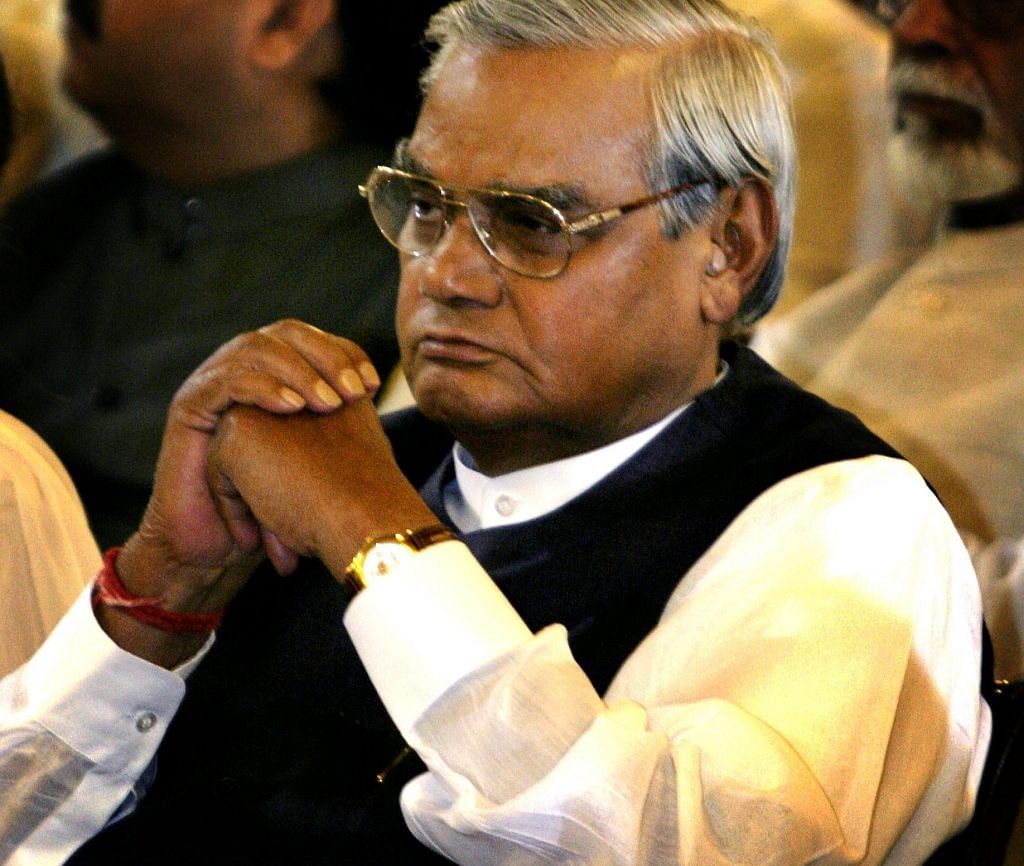Some talking heads were even trying to say that the emotional outpouring for Vajpayee was much more than it was for Indira.
Instead of comparing the working styles of Prime Minister Narendra Modi and Atal Bihari Vajpayee, television channels were plumbing new depths of absurdity last week by comparing the funeral processions of Indian leaders. The melodrama over Vajpayee’s death featured anchors asking panelists if the turnout was more at Jawaharlal Nehru’s funeral procession or Mahatma Gandhi’s.
They had to prove that Vajpayee was more popular than Nehru or Indira and could be in the league of the Mahatma. Some talking heads were even trying to say that the emotional outpouring for Vajpayee was much more than it was for Indira.
One of the panelists pontificated that Indira was assassinated and was the Prime Minister at that time. Vajpayee did not hold any post since 2004 and yet enjoyed such love and affection.
Some TV anchors were so impressed with the walk of Modi and Amit Shah during the funeral procession that they said no Prime Minister had undertaken such a trek.
Also read: My encounters with Vajpayee, a statesman who could smile even in a tough situation
Most political leaders, from Mamata Banerjee to Farooq Abdullah, Sharad Pawar to Naveen Patnaik, were making their obituary notes, stating that they were missing the “warm and human” touch that Vajpayee brought to politics. Sidelined BJP leaders like Yashwant Sinha and Arun Shourie were almost openly critical of the present Prime Minister while paying tribute to Vajpayee. But that kind of discussion was quickly shunned or discouraged.
One anchor noted that the BJP, and particularly Modi, have shown great respect to a “buzurg neta” like Vajpayee because that is the kind of gratitude they show towards elders. He either forgot or deliberately did not even mention the kind of treatment meted out to L.K. Advani and Murli Manohar Joshi in the last four years.
But despite the effort of TV anchors, it was hard to not compare. Modi has such deep hatred for Nehru and Indira that he is even trying to erase them from the national memory. But independent commentators recalled how Vajpayee was fond of Indira, how he described her as a courageous leader, and called her Durga. They talked about how Rajiv Gandhi went out of the way to ensure Vajpayee got excellent medical treatment in the US.
But the real blow to Modi’s sustained campaign against Nehru came when some news outlets quoted the former PM as having said in 1957 that “this man (Vajpayee) would become the Prime Minister one day”. Vajpayee, in a speech after Nehru’s death, had said: “In Panditji’s life, we see a glimpse of what the great poet said. He was a devotee of peace and yet the harbinger of revolution, he was a devotee of non-violence but advocated every weapon to defend freedom and honour”.
Also read: Vajpayee on Nehru’s death: Bharat Mata has lost her favourite prince
Why was this constant comparison made between Vajpayee and Nehru, who was the Prime Minister for straight 17 years, from 1947 to 1964? He was never defeated in any election. Vajpayee was defeated in 1984 by Madhavrao Scindia in Gwalior constituency. He was the PM for only six years (1998 to 2004, which includes the confidence vote defeat in 1999).
In fact, nobody gave any details of that confidence motion which the Vajpayee government lost by just one vote in April 1999. The architect of that defeat was Subramanian Swamy. He had reportedly joined hands with J. Jayalalithaa to topple the government. She had withdrawn her ministers from the cabinet, one by one, and that led to the crisis. Swamy roped in even Sonia Gandhi, and organised a tea party for her. He was so friendly with her then that it would hugely embarrass him today if he were to see the photos of that tea party.
Sharad Pawar negotiated with Mayawati and the Chautalas to vote against the government. But the clincher came from Giridhar Gamang, whose vote toppled the government.
That entire nail-biting drama was one of the major tragi-comic episodes in Vajpayee’s political life. But no channel asked Swamy or Pawar or Gamang (who joined the BJP later) about the no-confidence vote.
The villain of the piece was not the Congress but Swamy. Pawar had perhaps joined the game thinking that he had an opportunity to become the Prime Minister because he was the leader of the opposition (Congress). But then politics changed course radically. Mulayam Singh stalled Sonia Gandhi’s move (by raising the issue of her foreign origin) to claim a majority. A couple of months later, the Congress was vertically split by Sharad Pawar, who opposed Sonia’s Italian roots. No media outlet thought of recalling that thrilling drama.
Also read: Vajpayee was popular even among citizens who didn’t vote for him, writes his PMO aide
The birth of Pawar’s Nationalist Congress Party and defeat of the Congress in 1999 election, bringing back the Vajpayee government to power (with the same number of seats – 182), were the fallout of this situation. Without that split in the Congress and the Kargil War, Vajpayee perhaps would not have got the easy majority. He subsequently completed his tenure as the PM from 1999 to 2004.
No channel even bothered to analyse why the “towering leader” lost in 2004. An objective media should have analysed the context without undermining Vajpayee’s legacy. All absurd comparisons were made but an opportunity was lost to recount the events which, after the UPA interregnum of 10 years, brought Modi to power.
Kumar Ketkar is a former editor and Congress member of Rajya Sabha.
